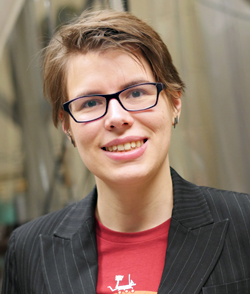
Jaclyn (Jax) Sanders ’09 is one member of a large team of scientists who today announced experimental confirmation of gravitational waves. Proof came by way of sound (sort of), making the LIGO scientific team a group of astronomers with an ear (rather than an eye) turned to space. Again, sort of. “We didn’t literally hear the waves,” explains Jax. “Sound is only an extended analogy–we observed shifts in the relative time of flight of two laser paths, which happened at frequencies between 50-350 Hz. If you translated those frequencies to sound, that would be about the range of a tuba.” Sight or sound (“We’re very sure that this signal is good,” says Jax), the observation work was for the purpose of detecting ripples in the fabric of space-time caused by the collision of two black holes a billion light-years away. The New York Times ran an in depth article on the magnitude of the discovery and its implications.
The waves (or ripples) were predicted by Albert Einstein a century ago when he developed his general theory relativity, which recast human perception of the universe from a Newtonian fixed and static framework to a more accurate model of flux deriving from a mathematically predictable dance of matter and energy and disturbances to both. If the general theory of relativity is indeed the key to the universe’s origin, shape and (perhaps) its eventual demise, then actual observation of gravitational waves would be one more empirical confirmation. They should exist, despite being invisible to the eye. And today, after decades of effort, it was announced that the waves have indeed been observed.
Jax’s personal involvement was as part of the commissioning team at LIGO Hanford (LIGO is the acronym for Laser Interferometer Gravitational-Wave Observatory). “I focused on the alignment and control system for the interferometer arms–solving the problem of how you keep two mirrors two and a half miles away from each other very still and pointing directly at each other, all without being able to physically touch them.”
“We’ve been watching the press conference here in the physics department,” said Professor of Physics Tom Askew. “It all looks great, a big day for physics. It’s nice for K that Jax started her work on gravitational wave research as a Senior Individualized Project eight years ago.” Jax explains: “I did my SIP research at LIGO Hanford, where I worked on a prototype system for synchronizing the outputs of two lasers located far away from each other using fiber optics. Although this system wasn’t necessary for use in the arm control system I worked on as a graduate student, I learned many of the basic skills I use to this day–radio frequency electronics, laser experimental skills, and signal analysis.”

Jax earned her B.A. at K in physics and studied abroad in Budapest, Hungary. In December she received her Ph.D. in physics from the University of Michigan, and she is currently working as a postdoc at Syracuse University. “Coming from a school like K gave me the opportunity to diversify my intellectual experience,” she says, “giving me a rich background to draw from when constructing public talks and scientific analogies, and giving me the freedom to learn about new and exciting fields through independent studies.” She appreciates her undergraduate professors as well. “Dr. Askew definitely encouraged me to continue working in experimental hardware, and I appreciate all the support I received as an undergraduate.”
Long ago Einstein wrote that the driving force of interrogations of nature at the edge of understanding was “the longing to behold a pre-existing harmony.” Nice to have a liberal arts educated K alumna working at that far boundary.”I’m thrilled to be a part of this discovery,” says Jax, “and can only hope to report back on more exciting research soon!”
